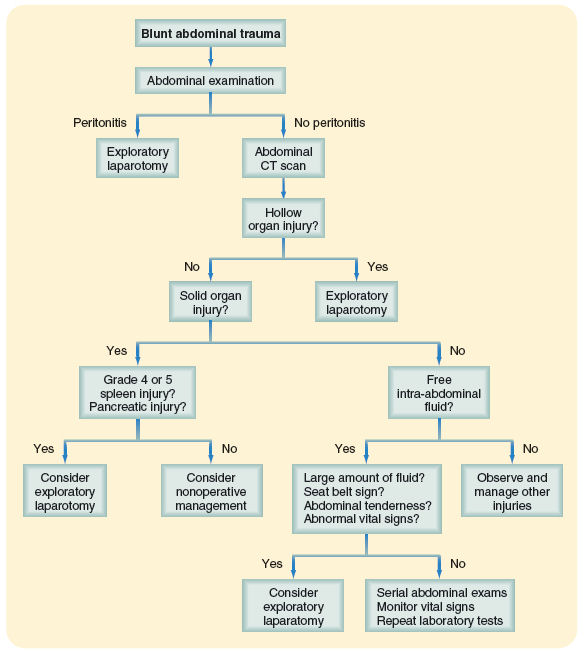Makindo Medical Notes"One small step for man, one large step for Makindo" |
|
|---|---|
| Download all this content in the Apps now Android App and Apple iPhone/Pad App | |
| MEDICAL DISCLAIMER: The contents are under continuing development and improvements and despite all efforts may contain errors of omission or fact. This is not to be used for the assessment, diagnosis, or management of patients. It should not be regarded as medical advice by healthcare workers or laypeople. It is for educational purposes only. Please adhere to your local protocols. Use the BNF for drug information. If you are unwell please seek urgent healthcare advice. If you do not accept this then please do not use the website. Makindo Ltd. |
Penetrating Abdominal Trauma
-
| About | Anaesthetics and Critical Care | Anatomy | Biochemistry | Cardiology | Clinical Cases | CompSci | Crib | Dermatology | Differentials | Drugs | ENT | Electrocardiogram | Embryology | Emergency Medicine | Endocrinology | Ethics | Foundation Doctors | Gastroenterology | General Information | General Practice | Genetics | Geriatric Medicine | Guidelines | Haematology | Hepatology | Immunology | Infectious Diseases | Infographic | Investigations | Lists | Microbiology | Miscellaneous | Nephrology | Neuroanatomy | Neurology | Nutrition | OSCE | Obstetrics Gynaecology | Oncology | Ophthalmology | Oral Medicine and Dentistry | Paediatrics | Palliative | Pathology | Pharmacology | Physiology | Procedures | Psychiatry | Radiology | Respiratory | Resuscitation | Rheumatology | Statistics and Research | Stroke | Surgery | Toxicology | Trauma and Orthopaedics | Twitter | Urology
Related Subjects: |Initial Trauma Assessment and Management |Thoracic Trauma Assessment and Management |Flail Chest Rib fractures |Resuscitative Thoracotomy |Haemorrhage control |Traumatic Head/Brain Injury |Traumatic Cardiac Arrest |Abdominal trauma |Tranexamic Acid |Silver Trauma |Cauda Equina
🩺 About
- Penetrating abdominal trauma = injuries from knives, sharp objects, or gunshots.
- Often associated with alcohol intoxication 🍺 and interpersonal violence.
- Liver & spleen = most commonly injured solid organs.
- Prognosis generally better than blunt trauma (unless major vessel injury).
🔎 Clinical Assessment
- ABCDE assessment is essential — airway, breathing, circulation, disability, exposure.
- Look for shock: tachycardia, hypotension, weak/absent femoral pulses.
- Inspect chest for associated thoracic injuries (e.g., pneumothorax).
- Abdomen: guarding, rebound, tenderness, absent bowel sounds.
- Rectal exam ➝ blood may suggest bowel/rectal injury.
- Do NOT remove impaled objects at the bedside ❌ — risk of uncontrolled bleeding.
🧪 Investigations
- Blood tests: FBC, U&E, LFT, clotting, amylase, group & crossmatch.
- Imaging: CXR & AXR (look for free air, diaphragm injury), FAST scan (detects free fluid/bleeding).
- Diagnostic Peritoneal Lavage (DPL): Positive if:
- RBC > 20,000/mm³
- WBC > 500/mm³
- Amylase > 200 U/L
- Bile or faeces present
 ⚡ Emergency Management
⚡ Emergency Management
- Initial resuscitation: High-flow O₂, 2x large-bore IV access, crystalloids ± blood products.
- Analgesia & monitoring: Pain relief, continuous vital signs.
- Surgical consult: All penetrating abdominal wounds require urgent surgical evaluation.
- Foreign body: Never remove in A&E — leave for surgical control of bleeding.
🚨 Indications for Immediate Laparotomy
- Persistent hypotension despite fluids
- Obvious evisceration (bowel protruding)
- Signs of peritonitis (rigidity, rebound, severe tenderness)
- Positive FAST/DPL
- Gunshot wounds to abdomen
📌 Key Clinical Pearls
- Always examine chest + pelvis — missed injuries are common.
- Hypotension post-penetrating injury = assume major vascular bleed until proven otherwise.
- Early senior surgical involvement improves survival.
- Damage control surgery may be required in unstable patients (control bleeding, temporary closure).
Cases — Penetrating Abdominal Trauma
- Case 1 — Stab Wound with Peritonitis: A 28-year-old man is brought to A&E after a knife wound to the left upper quadrant. He is tachycardic, BP 90/60, with diffuse abdominal tenderness and guarding. FAST scan shows free intra-abdominal fluid. Diagnosis: Penetrating abdominal trauma with haemodynamic instability (likely splenic or visceral injury). Management: Immediate resuscitation (ABC, IV fluids, blood products) and urgent exploratory laparotomy.
- Case 2 — Gunshot Wound with Hollow Viscus Injury: A 35-year-old man sustains a gunshot wound to the right lower abdomen. He is stable (BP 120/80) but has abdominal distension and tenderness. CT abdomen with contrast shows pneumoperitoneum and bowel injury. Diagnosis: Penetrating trauma with small bowel perforation. Management: Exploratory laparotomy, resection/anastomosis or repair of bowel, IV antibiotics, tetanus prophylaxis.
- Case 3 — Retroperitoneal Injury: A 40-year-old woman presents with a stab wound to the left flank. She is haemodynamically stable but has flank ecchymosis and haematuria. FAST scan is equivocal. CT abdomen reveals left renal laceration with contained retroperitoneal haematoma. Diagnosis: Penetrating trauma with renal injury. Management: If stable and contained → conservative with close monitoring; if unstable or expanding haematoma → surgical exploration.
Teaching Commentary 🩸
Penetrating abdominal trauma is high risk for visceral and vascular injury. Key principles: - Unstable patient with peritonitis or positive FAST → straight to laparotomy. - Stable patient → CT with contrast to define injuries. - Common injuries: spleen, liver, bowel, kidney, major vessels. - Always give IV antibiotics, tetanus prophylaxis, and blood products (damage control resuscitation). Management balances damage control surgery (haemorrhage control, contamination control) with definitive repair.